In this article:
Ear infections are caused by the overgrowth of bacteria or viruses in the inner, middle, or outer part of the ear cavity. Middle ear infection, medically referred to as otitis media, is the most prevalent form of ear infection that is caused by fluid accumulation in the air-filled space behind the eardrum. (1)

The middle ear is connected to the back of the throat via a narrow tube called the Eustachian tube. The opening of this tube in the throat keeps opening and closing to maintain proper airflow and pressure inside the middle ear and to drain out the secretions from the middle ear down the throat.
When you come down with a cold, flu, or allergy, inflammation and mucus buildup occur in the nasal passages, throat, and Eustachian tubes.
The blockage in the Eustachian tube prevents the drainage of fluid from the middle ear into the throat. As a result, the fluid starts collecting inside the middle ear and exerts pressure on the eardrum, causing it to bulge out and hurt.
The moist environment and lack of ventilation create an ideal environment for the growth of germs in the trapped fluid, eventually resulting in an infection. (2)
Yet another common ear infection is swimmer’s ear (otitis externa), which occurs when water gets trapped inside the outer ear canal and breeds the growth of infection-causing microbes.
Otitis externa typically causes redness, warmth, and pain in that stretch of the ear canal that extends from the eardrum to outside the head. (3)
Home Remedies for Ear Infections
You can try the following home remedies to reduce the pain, inflammation, and fluid discharge associated with some outer and middle ear infections.
1. Apply warm/cold compresses
Warm and cold compresses work in different ways to alleviate the symptomatic discomfort caused by ear infections.
The application of gentle heat helps dissolve the fluid discharge accumulated inside the ear so that it drains out easily, thus aiding in reducing symptoms. (4) Plus, it stimulates blood circulation in the targeted area, bringing more infection-fighting white blood cells to the ear.
Topical cold therapy, on the other hand, constricts the underlying blood vessels and thus limits blood flow in the area, reducing inflammation and providing cooling and soothing effects. Plus, it is a protective method that prevents hearing loss. (5)
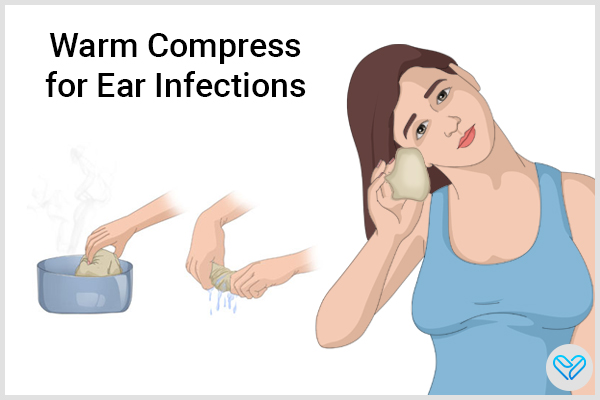
To make a warm compress:
- Soak a clean washcloth in warm water, squeeze out the excess liquid, fold the damp cloth, and place it over the infected ear for 10–15 minutes.
- Alternatively, you can wrap a heating pad (on low setting) or warmed gel pack in a towel and keep it on the sore ear for 10–15 minutes.
Make sure that the compress does not feel too hot as you can end up burning your skin.
To make a cold compress:
- Soak a clean washcloth in cold water, wring out the excess liquid, fold the damp cloth, and place it on the infected ear for 10–15 minutes.
- Alternatively, you can wrap a few ice cubes or a bag of frozen vegetables in a thin towel, and place it over the infected ear for 10–15 minutes.
You can try both hot and cold compresses to see which one suits you best, and then stick to the preferable option. Or you can alternate between the two every 10 minutes to get the therapeutic benefits of both.
2. Use garlic
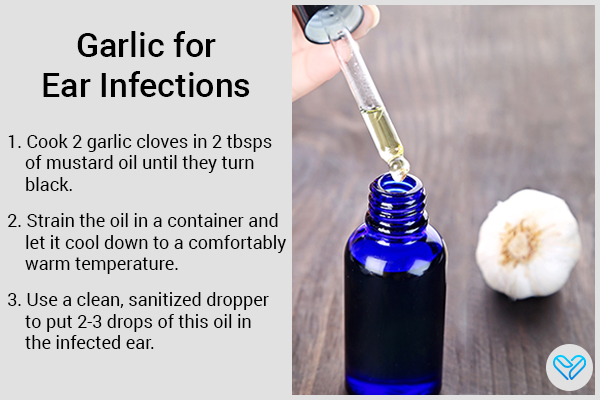
Garlic exhibits strong antimicrobial and immune-boosting properties that can help fight ear infections, reduce your symptoms, and promote faster recovery. Plus, it is credited with pain-relieving properties (6) that can help ease infection-induced earache.
Method 1
- Cook two garlic cloves in 2 tablespoons of mustard oil until they turn black.
- Strain the oil in a container and let it cool down to a comfortably warm temperature.
- Use a clean, sanitized dropper to put 2–3 drops of this oil in the infected ear.
Method 2
- Put a few fresh garlic cloves in boiling water for about 5 minutes.
- Crush the softened cloves.
- Add a little salt to the crushed garlic.
- Wrap this mixture into a clean cloth and place it against the affected ear.
Method 3
Chew some fresh garlic cloves every day to bolster your immunity and accelerate the healing process.
3. Try using tea tree oil
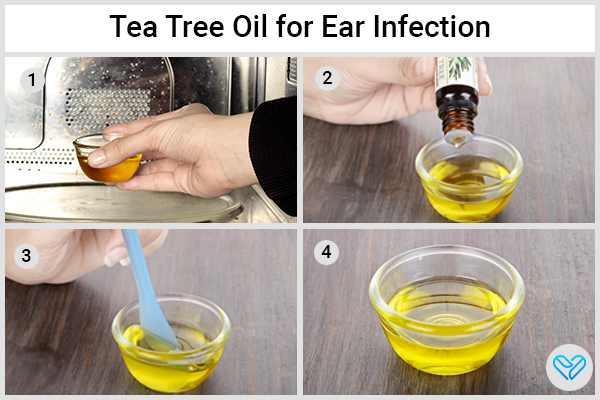
Tea tree oil is endowed with multiple medicinal effects that can help treat ear infections and their associated symptoms. It is a potent antimicrobial agent that can kill the germs responsible for the infection.
Moreover, it helps relieve the inflammation and pain in and around the infected ear while also pulling out the fluid buildup from inside the ear canal. (7)
How to use:
- Heat a tablespoon of olive oil until it becomes slightly warm.
- Add 3–4 drops of tea tree oil and mix.
- Lay your head down on your side with the infected ear facing up. Put 2–3 drops of warm oil blend into the ear with a dropper.
- Hold the position for about 3 minutes
- Turn your head to drain the oil out.
- Repeat daily until the pain subsides.
4. Apply a salt compress on the affected area
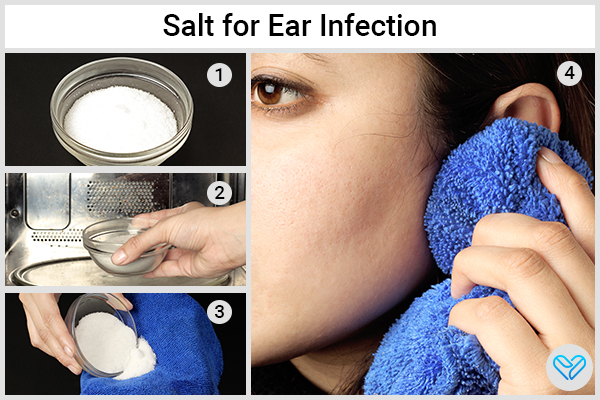
Salt is a natural anti-inflammatory agent that can help soothe the swelling, pain, and tenderness in and around the infected ear.
Salt draws out the pus or fluid discharge from the ear to provide relief and promote healing. It may even help kill the bacteria responsible for the ear infection to speed up recovery. (4)
The best way to use this therapeutic ingredient is in the form of a warm compress.
How to use:
- Fill a bowl with salt.
- Heat it in the microwave for 5–6 minutes.
- Put the heated salt in a clean sock.
- Use a thread or rubber band to tie the open end of the sock.
- Lie down and place this warm sock over the affected ear. The application of salt and heat will help expel the pus or fluid accumulated inside the ear.
- Use a clean tissue to gently wipe any discharge that comes out of the ear.
- Repeat this process several times a day for prolonged relief.
5. Onion compress application may help
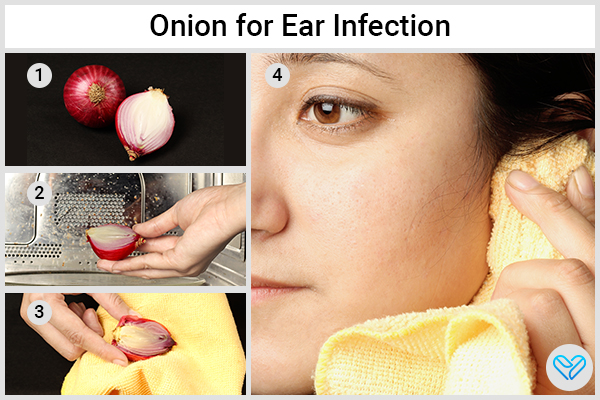
Onions contain anti-inflammatory compounds such as the flavonoid quercetin, which can help reduce the swelling and pain caused by ear infections. (8)
This is a widely popular anecdotal remedy that has been used for ages, but there isn’t much scientific support for it. However, you can still give it a try since it is devoid of any harmful side effects.
How to use:
- Use a clean dropper to put a few drops of onion juice in the affected ear.
- Heat half an onion in the microwave for 30 seconds.
- Wrap it in a thin towel to make a hot compress.
- Keep the onion compress over the affected ear until it cools down.
6. Use holy basil
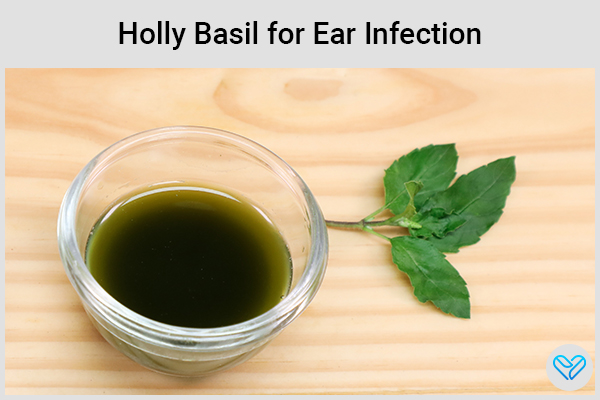
Holy basil is rich in antibacterial, anti-inflammatory, antioxidant, and immune-boosting effects (9) that can help clear ear infections and improve symptoms.
Method 1
- Lightly crush 4–5 fresh holy basil leaves to extract their juice.
- Soak a clean cotton ball in the basil juice.
- Carefully dab it on and around the affected ear without getting any liquid into the ear canal.
Method 2
- Mix a few drops of holy basil oil with equal amounts of coconut oil.
- Dip a clean cotton ball into the mixture.
- Use it to gently wipe the inside of your ear, its outer edges, and the area behind the ear.
- Do this daily until the infection goes away.
7. Pour olive oil in the affected ear
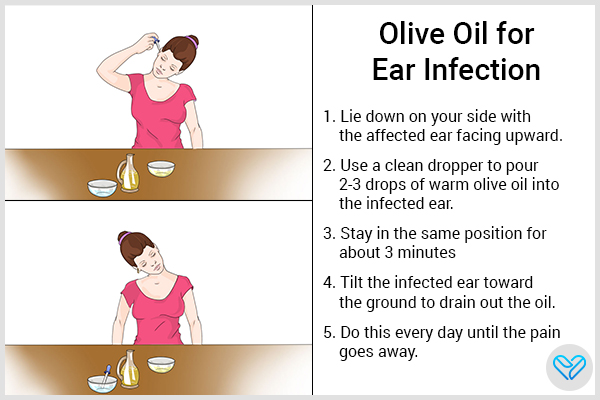
Olive oil possesses some antibacterial activity, but there isn’t enough research to prove that it works against the bacterial strain that commonly causes ear infections.
It also exhibits anti-inflammatory properties that can help ease the ear pain associated with such infections, but not as effective as commercial eardrops that contain actual anesthetic formulations.
All things considered, this remedy is quite safe, so there is no harm in trying it.
How to use:
- Lie down on your side with the affected ear facing upward.
- Use a clean dropper to pour 2–3 drops of warm olive oil into the infected ear.
- Stay in the same position for about 3 minutes
- Tilt the infected ear toward the ground to drain out the oil.
- Do this every day until the pain goes away.
8. Put mango leaf juice in the affected ear

Mango leaf juice has long been used as a natural remedy to get immediate relief from earaches. It possesses some degree of anti-inflammatory and antibacterial properties that can help soothe and heal your infected ear.
In one study, mango extract, administered topically (0.5–2 mg per ear), reduced ear edema in mice. (10)
How to use:
- Grind or crush 2–3 mango leaves to extract their juice.
- Use a clean dropper to put 2–3 drops of this juice in the infected ear.
- Keep still for about 5 minutes.
- Repeat the procedure three times a day.
9. Breastmilk can reduce the risk of ear infections in children
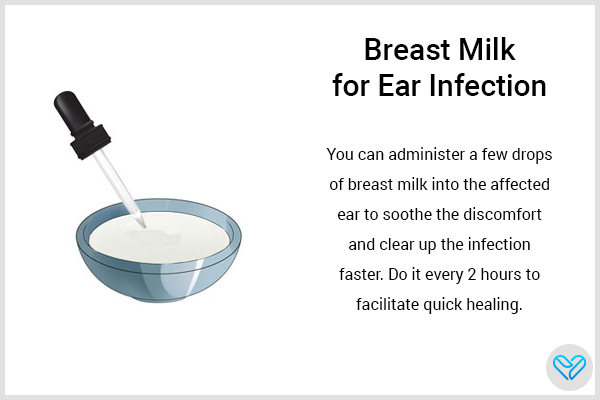
Infants between the ages of 6 and 18 months are quite prone to outer ear infections, but breastfeeding can greatly reduce this risk. This is because breast milk is replete with antibodies that strengthen your child’s nascent immune system (11) against such infections.
It was found that babies who were breastfed for about a year were less susceptible to outer ear infections than those who never received breast milk.
Moreover, you can administer a few drops of breast milk into the affected ear to soothe the discomfort and clear up the infection faster. Do it every 2 hours to facilitate quick healing.
10. Mullein drops can soothe ear infections
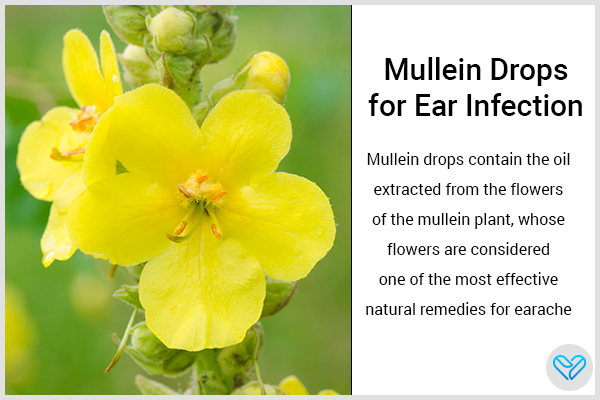
Mullein is available in many forms in the market such as oils, ear drops, tinctures, creams and capsules, etc. But in case of ear infections mullein ear drops (in oil form) is preferred which is extracted from the mullein flowers.
The Archives of Pediatrics and Adolescent Medicine published some research that showed that the pain-relieving effects of mullein ear drops were comparable to a standard anesthetic. (12)
11. Increase your vitamin D intake

Vitamin D plays a crucial role in building your immunity, but unfortunately, most people run low on this vital nutrient. Conversely, vitamin D deficiency compromises your body’s ability to ward off various ailments, including ear infections.
A proper diet, adequate supplementation, and direct sun exposure can help increase your vitamin D levels and thus reduce the risk of ear infections. (13) This simple intervention can also help you recover from such infections much faster.
Preventing Ear Infections
Here are some useful tips that can help reduce your risk of contracting ear infections:
- Don’t insert your finger, Q-tips, or any other sharp instrument inside the ear to clean it. This may be a common practice, but it is quite counterproductive and ill-advised by most experts. The inside of the ear is extremely delicate and can easily get damaged. Plus, putting a foreign body inside the ear can introduce germs into the ear cavity and give rise to ear infections.
- Cover your ears with a swimming cap or earplugs when going for a swim.
- Be careful not to let water or shampoo trickle inside the ear while taking a shower or bath. Wearing a shower cap may help in this regard.
- Seek proper treatment for any condition affecting your ears such as eczema or allergy.
- Take all the necessary steps to minimize exposure to secondhand smoke.
- New mothers are advised to breastfeed their babies for at least 6 months to provide them some much-needed antibodies that can offer protection against ear infections.
Most-Asked Questions About Ear Infections
What are the symptoms associated with ear infections?
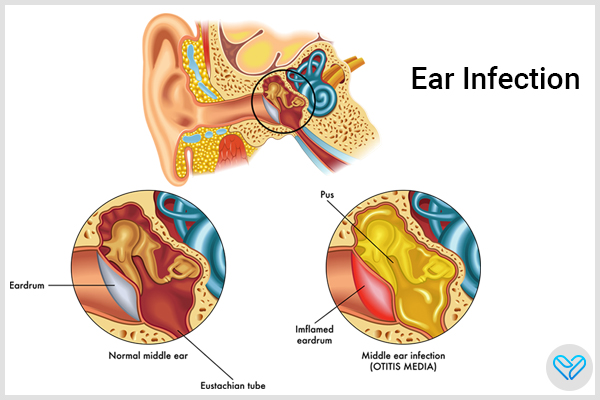
Ear infection is commonly associated with the following symptoms:
- Earache
- Inability to hear properly
- Ear discharge, medically known as otorrhea
- Ringing in the ear, medically known as tinnitus
- Vertigo
Since pain and discomfort in the ear can sometimes stem from your teeth, tonsils, salivary glands, tongue, throat, and temporomandibular joint, the doctor will examine these areas as well along with your ears, nose, nasopharynx, and paranasal sinuses to arrive at a proper diagnosis.
The doctor will also test your cranial nerve function, hearing, and the vestibular apparatus.
Can antibiotics, which are used to treat infections, cause hearing loss?
Yes, antibiotics used in treating ear infections can cause hearing loss, and the group of antibiotics that are most likely to cause hearing loss is called aminoglycosides. These include gentamycin and streptomycin. (14)
Can hearing loss caused by antibiotic treatment be reversed?
There is no clear answer to this. In some cases, it can be reversed, but it may be irreversible in other cases.
Can I prevent antibiotic-induced hearing loss?
The use of antioxidants can effectively prevent aminoglycosides-induced ototoxicity, but there is not much research on this. (15)
How do doctors prevent such a type of hearing loss?
The risk of hearing loss caused by aminoglycoside antibiotics can be minimized if you take the medication promptly and for an adequate period of time, which will depend on its dosage.
To that end, the doctor will keep a close tab on the serum peak (highest concentration) and trough (lowest concentration) levels of the medication in the patient’s body. (16) This type of drug monitoring allows the doctor to determine the appropriate gap that needs to be maintained between consecutive administrations of the medication.
Peak levels are delayed to allow the medication to be distributed throughout the body. In contrast, the trough level is measured immediately before the next administration of the medication. Peak and trough levels are usually recorded after the second or third dosage.
What are the other major ear infections?
Acute mastoiditis is a serious ear infection that usually develops as a complication of acute otitis media or acute middle ear infection, (17) but it can occur without any clinically obvious cause before the onset of acute otitis media as well.
This condition can be quite severe despite antibiotic and surgical treatment. It can affect people of all ages, but it is most prevalent among young children below the age of 2 years.
Myringitis is a type of acute middle ear infection characterized by the formation of small fluid-filled sacs or vesicles on the eardrum or tympanic membrane. It is mostly viral in nature, but it can occur with bacterial (particularly Streptococcus pneumoniae) or mycoplasmal infection as well.
This condition typically causes sudden ear pain that lasts for 24–48 hours. If the patient experiences hearing loss and fever, bacterial otitis media is the most likely culprit. (18)
Which antibiotics are safe then for treating ear infections?
Here are some commonly prescribed antibiotics for ear infections:
- Ciprofloxacin
- Delafloxacin
- Gemifloxacin
- Levofloxacin
- Moxifloxacin
- Norfloxacin
- Ofloxacin
Final Word
Ear infections are quite common but can cause considerable pain and discomfort while they last. If your symptoms are not too severe, you can try the above-listed natural remedies to get natural and immediate relief.
However, if your condition persists or worsens after a day or two of home treatment, go see a doctor. It is also important that you consult your doctor before trying any homemade eardrops to rule out the risk of potential ear damage.
If ear infections are left untreated, they can spread further inside the ear, turn severe, become recurrent, and cause serious complications such as hearing loss.
- Was this article helpful?
- YES, THANKS!NOT REALLY


